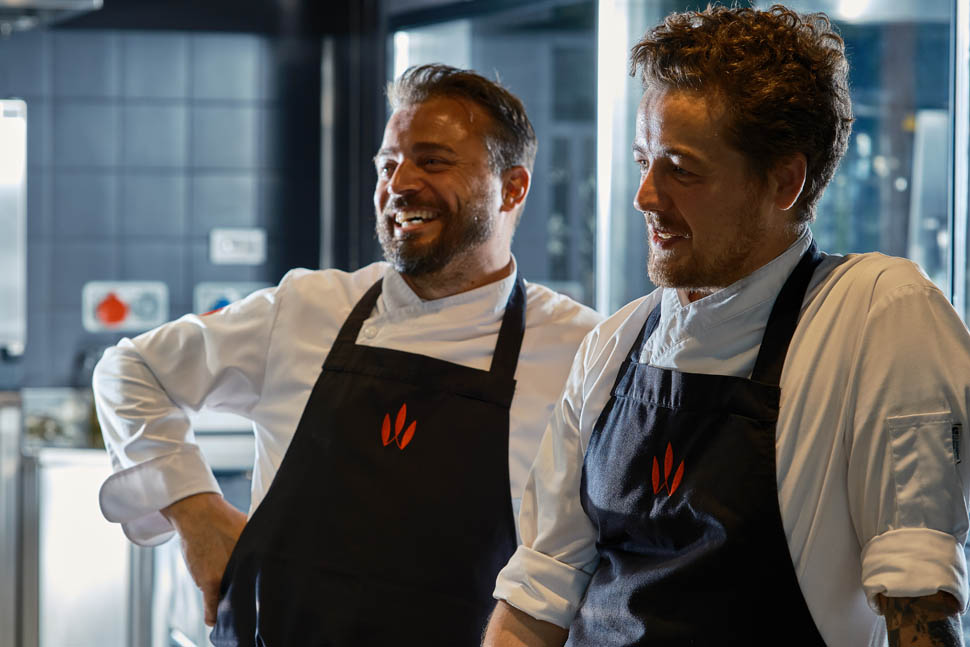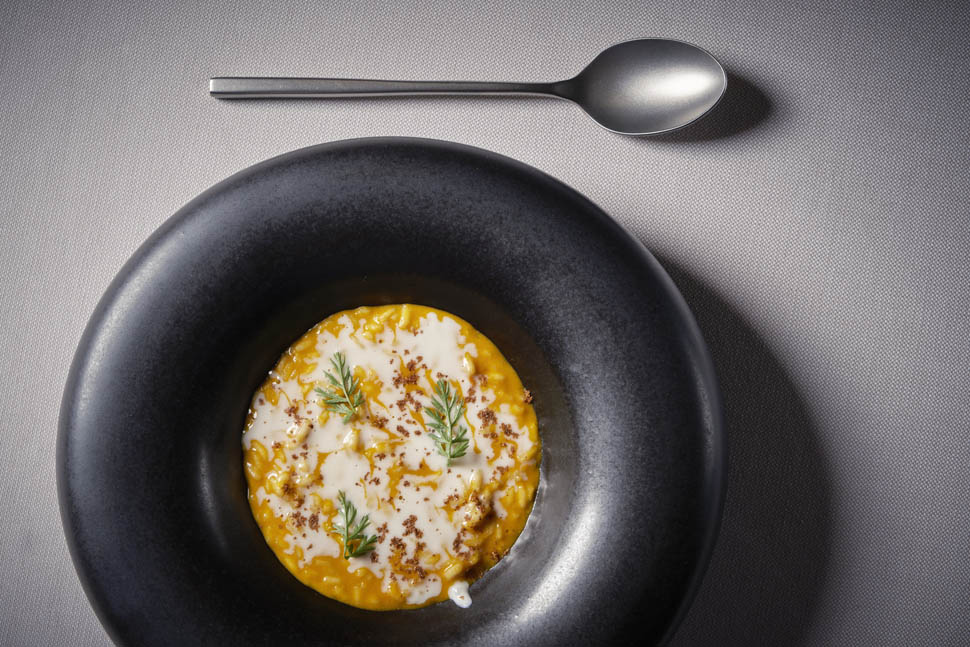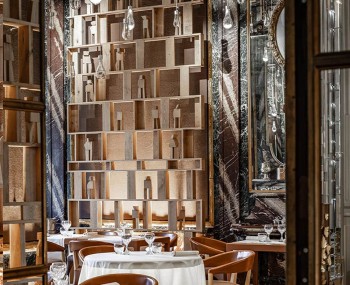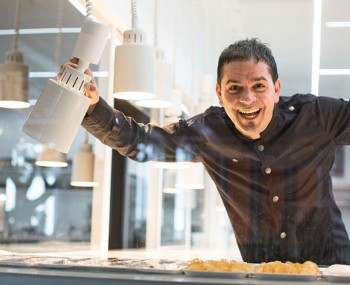After numerous experiences from Milan to Sardinia, he returns to his village in the Colli Orientali del Friuli to lead the new gourmet project of Hotel Le Fucine: the new adventure of Andrea Fantini.
The hotel
Buttrio is located among the Colli Orientali del Friuli, a wonderful wine-growing area, so much so that it is also known as the 'City of Wine'. Defiladed, very convenient to reach, Le Fucine is a modern hotel that runs between two blocks, equipped with every comfort and with a beautiful, quiet garden around it. Owned by the Danieli Group, among the first in green facilities for the steel industry, the project is inspired by the Olivetti’s vision of cultural enterprise, with the idea of achieving a kind of sustainable continuity between environment and structured system.



The 64 rooms, of various types, bright and with well-articulated spaces, share a refined essentiality and surfaces made of natural materials. There is no shortage of a business center and a large wellness area, with SPA and Beauty Center, also accessible to outside guests. Beautiful light in the common parts, elegant, one area in particular with the classic fogolâr represented in a contemporary key.



A welcoming place, strategic because it suits both a business clientele and those who want a convenient landing place, either to explore the beautiful surrounding hilly area by exploring interesting wineries, or as a base to move between the main destinations throughout Friuli-Venezia Giulia.

The food offer
The project could only be completed by gastronomic offerings that match the context: the well-kept Café & Bistrot, created, outside the structure, from the expert restoration of a gas station designed in the 1960s by architect Marcello D'Olivo, functions from breakfast to evening aperitifs, with excellent homemade pastries; again, the Brasserie, with traditional cuisine and grilled meat at Josper, and finally the fine dining.

Overseeing the kitchens is Andrea Fantini, a Buttrio native and class of 1982, who is joined by younger co-regional Maurizio Piani, a sous chef originally from Collio and with important experience, in addition to Fantini himself, with Pietro Leemann at Joia in Milan and with Matteo Baronetto at Del Cambio in Turin.
Le Fucine Gourmet is an intimate and cozy space, and from the table you can watch the chefs at work: the welcome is taken care of by the talented maître d' and sommelier Nicholas Chiarcossi, capable of putting anyone at ease with a service of professional informality.


It is worth letting him advise you on wines because, in addition to his excellent knowledge, Nicholas has a list that already boasts more than five hundred labels, with notable regional goodies.
Fantini tells us his story, starting with a significant anecdote: "I am particularly attached to this place, because it was my first place of work: I was 15 years old and this was originally a village hotel at the end where weddings, baptisms and communions were held. At that time I was studying and on weekends I would come here and help out. Over time I had my experiences and then I came back: besides being proud of it, something like this goes to my heart." Andrea joined the project in 2020, after staying several years at Elliot's in Manzano: "The ownership cares a lot about it, it's a very important calling card even for customers coming from abroad."


Fantini became a cook due to a series of family circumstances that led him in an obligatory direction: "My grandfather had a village store where there was really everything in it, from clothes to the gas cylinder, and he would make do with everything, fix you up from your bicycle to your guitar string; my father, on the other hand, was a mechanic, so in the end, since in the Friulian mentality there is 'leave it, I'll do it' I grew up a total klutz. The only thing they couldn't do was cook, they couldn't even make coffee, so I stuck to my mom; she gave me more space and with her I made gnocchi, crostoli, cakes. Eventually I slipped in between her and Grandma. At home we had a big tavern, and my parents loved to host people, starting with the town notables; I could see the contentment in people's eyes. That's where the spark was born that is still there, in fact my greatest satisfaction is seeing that one appreciates what you do."

Fantini started in Friuli, from the grassroots, making his bones with trattorias and traditional cuisine, then "from there I slowly sought out restaurants that I believed did well for my experience." He goes to Milan to the Four Seasons at the time of Sergio Mei: "Between 2006 and 2008 there were more than thirty people in the brigade, he gave me method and taste and there I met colleagues from all over Italy, tasting every possible dish from all regions." Then it was time for the opening of L'Orsone in Cividale with Joe Bastianich: "We were only two Friulians, the rest were Americans, Canadians Koreans: the first days were really hard but it was also very nice." After the Orsone Andrea makes a stop in Sardinia and then arrives at the Elliot. It was here that he was recruited for the new opening at Le Fucine, starting with the Cafe Bistrot and then coming to port with fine dining a little over six months ago.

"I had the opportunity to work on the plans for the kitchens, the choice of equipment, the setting up of the work, the staff, the suppliers, there was carte blanche on everything and that was a source of pride for me. Now, seeing people leave happy takes all the effort out of it for me." What Fantini came up with for Le Fucine Gourmet is "the tale of a chef's journey, because that's where you can be original. Telling your past, without going after fads, doing what you know how to do and contextualizing it by looking around you."
The dishes

The result is ideas of considerable gastronomic depth: you can choose from a menu, creating yourself a 4- or 6-course menu, or rely on the kitchen with 8 surprise dishes (65, 85, and 100 euros, respectively). After a series of decidedly centered amuse bouche, we start off very well right away with sea urchins, wild garlic, and glasswort: it starts with a base of white polenta, topped with fresh bear garlic leaves; the sea urchins are served two ways, with the fresh fruit and in sauce, the glasswort, on the other hand, is sautéed raw, so as to retain its original crunchiness. Also delicious is langoustine and cucumber.

The crustaceans are freshly char-grilled, the langoustine bisque shrunk and whipped as if for a mayonnaise; they are served with a slightly spicy cucumber gazpacho, spheres of the same vegetable in osmosis with lime juice, confit langoustine roe, and finally an oyster leaf that gives a nice herbaceous finish. Scallops, daikon, and beurre blanc is one of the rare occasions when this shellfish takes on a prominent mouthwatering value. The scallops are seared au naturel, their tripe cooked like an Italian-style ragout and enriched, at the time of serving, with veal marrow, fresh chives and fried capers; the daikon, from the Orto Felice company, is processed like a kimchi, left to ferment without letting it lose its texture and served sliced in the center of a puffed beurre blanc sauce. The taste idea behind veal heart, bell pepper and pecorino cheese is excellent.

"We find the heart very versatile for pairings, but above all it gives us extreme satisfaction from a flavor point of view: it is simply pan seared, because when barbecued we noticed too radical a change in its natural taste; we serve it with a pappa al peperone, made like a classic pappa al pomodoro but replacing the vegetable. Depending on the time of year, we decide how to treat them (in early summer they are perfect, having not yet reached too much sweetness and body): they are quickly seared on the grill and finished in the oven; around the meat we put a foam of semi-matured pecorino cheese and, to bind it all together, we finish with veal stock and fresh oregano leaves. This dish reminds us of Italian taste, attention to seasonality and study on how to develop the recipe are of paramount importance." Riccioli pasta, canocchie and saffron is a small masterpiece.

"The idea is to serve a pasta with fish that changes according to the time of year, in this case accompanied by a 'blizzard' in white of canocchie, the same just steamed and, at the base, a saffron cream; all scented with marigold in all its forms: in leaf, in flower and in essential oil." Also hitting the mark is risotto, carrot and horseradish, an only seemingly simple vegetable dish. The rice is cooked in a carrot extract; in the creaming final process, a brunoise of the same vegetable is added to give the crunchy feel; to finish, horseradish in a sauce, a little less intense than raw, and a star anise powder.


Perfect meat texture, well balanced by the vegetable side, for the venison with garlic, parsley and wild spinach: the sirloin comes from the hunting grounds of Mitteleuropa, makes a quick pass through the pan to remain pink in the center and is served with a garlic cream, a lightly acidulated parsley foam, wild spinach sautéed with toasted sesame, 'burnt' oil (flavored with vegetable scraps and ginger then dried) and finished in the room with its brown bottom. Sumptuous dish, pigeon, perigord and chard: the bird matures for 21 days in beeswax and is cooked whole; the breast is separated and processed with a glaze made from its base, along with white and black pepper, long pepper, timut pepper, nutmeg and coriander seeds. The base is made from red wine, black truffle and pigeon.


The chef tells us that "the vegetable part of the dish changes according to availability, in this case a baby chard was served, but we usually pair it with a spring onion to give it the right freshness and sweetness." It concludes, in finesse and goodness, with a remarkable dessert: a brunoise of white asparagus at the base, burnt klotzen pear gel, almond mousse and white asparagus sorbet; to close, a brown rice waffle, lime gel and cornflower blossom. A stop in Friuli not to be missed.












